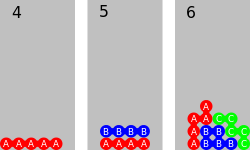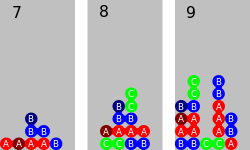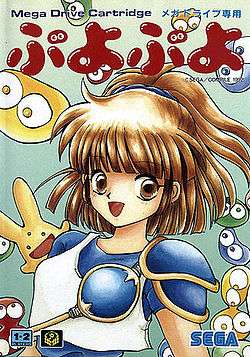Puyo Puyo
| Puyo Puyo | |
|---|---|
|
The front cover of the Mega Drive version of the original game. | |
| Genres | Puzzle |
| Developers |
Compile (1991-2000) Sonic Team (2001-present) |
| Publishers | Sega, others |
| Creators | Kazunari Yonemitsu |
| First release |
Puyo Puyo October 25, 1991 |
| Latest release |
Puyo Puyo Tetris February 6, 2014 |
Puyo Puyo (ぷよぷよ), often marketed as Puyo Pop in North America and Europe, is a series of tile-matching video games created by Compile. Sega has owned the franchise since 1998, with most releases after 2001 being handled by Sonic Team.
History
Compile-developed games
The first Puyo Puyo title was developed by Compile released in 1991 for the MSX2 and Family Computer Disk System; the latter release was published by Tokuma Shoten as a pack-in for their Famimaga magazine. The puzzle game features characters from the 1990 RPG Madou Monogatari 1-2-3, also developed by Compile. The titular gelatinous puzzle pieces, later known as simply Puyo, were Madou Monogatari's equivalent of the Slime monsters from the Dragon Quest game series. The game includes "Endless" mode, where the player attempts to amass a large score, "Mission" mode, where the player is given a pre-configured board and must attempt to satisfy conditions, and a two-player competitive mode.
Compile and Sega collaborated to create an arcade version of Puyo Puyo that released in October 1992 for Sega's System C2 hardware.[1] Unlike the previous release, this title focuses entirely on competitive play; the single-player mode consists of a gauntlet consisting of either 3, 10, or 13 computer opponents, while the multiplayer mode allows two human players to battle each other. The game was ported to several major platforms in Japan, with the Mega Drive becoming a bestseller.[2] The game was followed by Puyo Puyo Tsu in September 1994, also released for Sega System C2.[3] Tsu adds the ability to counter the opponent's chains; additionally, it changes the single-player gauntlet from a linear structure to a roulette-based structure that requires the player to pass certain score thresholds to advance. Like its predecessor, Tsu was also released on a variety of home platforms. In 2004, it was included in the Sega Ages 2500 line of PlayStation 2 games.
Puyo Puyo Sun, released in 1996 for the Sega Titan Video arcade hardware, adds a "Sun Puyo" mechanic that allows the player to send extra Nuisance to opponents. Puyo Puyo~n, released in 1999 for the Sega Dreamcast, adds character-specific powers that assist the player in clearing Puyo. Compile's final Puyo Puyo game, Puyo Puyo BOX, includes ports of the first two arcade games alongside original content.
Compile also released a variety of spinoff titles on home consoles, handhelds, and through their Disc Station disk magazine. The Nazo Puyo series expands on the original Puyo Puyo's Mission mode, with the 1994 Nazo Puyo: Arle no Roux for Game Gear, 1995 Super Nazo Puyo: Rulue no Roux for Super Famicom and 1996 Super Nazo Puyo Tsu: Rulue no Tetsuwan Hanjouki for Super Famicom introducing RPG elements. Other notable spinoffs include the roguelike Waku Waku Puyo Puyo Dungeon (1998, Sega Saturn and PlayStation), Puyo Puyo DA! dancing game (1998, Arcade and Dreamcast), and Arle no Bouken: Mahou no Jewel monster-collecting RPG (2000, Game Boy Color).
Sonic Team-developed games
Sonic Team's first Puyo Puyo title was Minna de Puyo Puyo; the Game Boy Advance title was released in Japan in 2001 and elsewhere in 2002 as Puyo Pop. It is one of three games named Puyo Pop, the others being the Neo Geo Pocket Color port of Tsu and an N-Gage-exclusive title.
Sega released Puyo Pop Fever on November 2003 for their NAOMI arcade hardware. The game features an almost entirely-new set of characters, alongside new gameplay mechanics such as Fever Mode. Like its arcade predecessors, Fever was ported to many platforms; the Dreamcast version notably serves as Sega's final first party video game. A direct sequel, Puyo Puyo Fever 2 was released in 2005. Fever 2 added more characters and an expanded single-player mode. Puyo Puyo 7, released in 2009, adds a third protagonist and includes a new "Transformation" gameplay system.
In addition, titles celebrating Puyo Puyo's 15th and 20th Anniversary were released. Puyo Puyo! 15th Anniversary (2006) includes more than ten gameplay rulesets, including the rules of the first Puyo Puyo, Tsu, and Fever, reintroduces characters that were absent from the series since Minna de Puyo Puyo, and gives every character in the game a single player story. Puyo Puyo!! 20th Anniversary (2011) adds even more rulesets, such as Sun rules.
Puyo Puyo Tetris, released in 2014, includes both Puyo Puyo and Tetris gameplay.[4]
Puyo Puyo!! Quest is a free-to-play RPG released for iOS and Android in 2013. Sega has claimed that the game is a major success, and stated that the game has reached 11 million downloads and a monthly income of over 500 million yen (approx. $4 million USD, using Feb. 20, 2015 exchange rates) as of February 2015.[5]
Puyo Puyo was a mini-game in Hatsune Miku: Project Mirai Deluxe/DX in 2015. In the mini-game, the Vocaloid you play with has to win against the Vocaloids that you are not playing as currently. Also costumes of Arle and Satan are unlockable in the mini-game.
Puyo Puyo Chronicles will be released on December 8, 2016, in Japan for Nintendo 3DS, as part of the original Puyo Puyo game's 25th anniversary. Unlike the other anniversary titles, this game features an RPG mode, althrough the classic rules are also included, and features a new character named Allie.[6]
International releases
The 1992 arcade Puyo Puyo was released in English with character name changes and minor censorship to the Harpy (renamed Dark Elf) character. However, there is little concrete information regarding its release, and it is known mostly through the MAME arcade emulator. The Game Gear port of the 1992 arcade game, when used in a non-Japanese Game Gear, loads a similar version titled Puzlow Kids; however, the Game Gear version never officially left Japan.
Instead of directly translating the Mega Drive version of the 1992 arcade game, Sega decided to replace the Madou Monogatari cast with Adventures of Sonic the Hedgehog villains. The resulting game, Dr. Robotnik's Mean Bean Machine, was released in 1993. Nintendo followed suit in 1995, modifying Super Puyo Puyo into Kirby's Avalanche (Kirby's Ghost Trap in Europe). Spectrum HoloByte also released a Puyo Puyo title for Microsoft Windows 3.1 and the Macintosh in August 1995, under the name Qwirks.[7]
The next localized release was in 1999, when SNK published the Neo Geo Pocket Color port of Puyo Puyo Tsu in English as Puyo Pop. Unlike the arcade translation, most characters kept their original names; only the character Satan retained his English arcade title of Dark Prince. After the Game Boy Advance Puyo Pop, Puyo Pop Fever saw worldwide release, with North America receiving the GameCube and Nintendo DS versions and Europe receiving it on the majority of platforms it came out on. Finally, the Mega Drive version of Tsu was released, untranslated, on the Wii's Virtual Console as an import title and the arcade version of Tsu is included in Sega 3D Classics Collection. Also the N-Gage Puyo Pop was released worldwide in 2003. As the game Hatsune Miku: Project Mirai Deluxe/DX was released worldwide, consequently also its Puyo Puyo mini-game saw release also outside Japan. Like in many other English translations of the series, the Satan costume is named the Dark Prince costume.
Other releases
An unofficial Puyo Puyo game named Super Foul Egg was featured as a cover disk for Amiga Power after the magazine commented that the Amiga lacks a good substitute.
Disney Interactive published a new Puyo Puyo game for Windows 95 and Macintosh named Timon & Pumbaa's Bug Drop in 1995 as part of Disney's Game Shot series of PC games. This version features Disney characters Timon & Pumbaa from The Lion King, and Puyos are represented by bugs.[8]
In July 2005, Bandai released Kidou Gekidan Haro Ichiza: Haro no Puyo Puyo (機動劇団はろ一座 ハロのぷよぷよ) (lit. "Mobile Theatrical Company Haro: Haro's Puyo Puyo") in Japan for the GBA.[9] It is based on the Mobile Suit Gundam anime series and presented in the style of the SD Gundam series. In this game, Puyo are replaced by Gundam's mascot, Haro.
Other clones include the 1995 game Outfall for Amiga[10] and Candy Crisis for Windows and OS X.[11]
On September 10, 2015, it was announced that Rin Hoshizora of the anime Love Live! will serve as the new star of the Puyo Puyo titles, though it is unknown if this is to be a one-time spin-off title (similar to Haro no Puyo Puyo) or a part of the main series.[12]
A new mobile game titled Puyo!! Touch was released for iOS and Android devices in November 26, 2015.[13]
It's also available a free-to-play version of Puyo Puyo for Microsoft Windows named Puyo Puyo VS., what focuses principally on multiplayer battles.[14]
Capcom's Super Puzzle Fighter II Turbo features a similar gameplay to the Puyo Puyo series (in particular to Puyo Puyo Tsu), as well as similar rules to Tsu named Sousai (Garbage Countering).
Gameplay

The objective of the game is to defeat the opponent in a battle by filling their grid up to the top (usually the rows directly below the spawn point) with garbage. The Puyo (plural: Puyo) are round, slime-like creatures who, in most variations of the game, fall from the top of the screen in pairs, triplets, or tetrads. The piece can be moved, dropped, and rotated using the controller or joystick. The piece falls until it reaches another Puyo or the bottom of the screen.[15]
When four or more Puyo of the same color line up adjacent to each other, they disappear. Puyo connect horizontally or vertically, but not diagonally; the whole group need not be a line, but can be any tetromino or larger. This is called Popping. For example, the A pieces pop in grids 1 and 2, but not 3.

The Puyo above those that are cleared fall onto other pieces or the bottom of the screen. Simultaneous Pops (同時消し, simultaneous erasing) are created when more than one group is formed at a time. For example, grid 4 has a popping group of five, grid 5 has two Simultaneous Pops of four for a total of eight Puyo popped, and grid 6 has three groups of five for fifteen Simultaneous Pops.

A Chain is made when falling Puyo cause a new group of Puyo to Pop, making a chain reaction. For example, grid 7 will form a 2 Chain, grid 8 will form a 3 Chain, and grid 9 will form a 5 Chain.
When a Chain is achieved, Nuisance Puyo, or Ojama Puyo (お邪魔ぷよ, hindrance Puyo) are sent to either clog the opponent's screen or to cancel out the Nuisance Puyo sent by the opponent (This is called Offsetting (相殺, offsetting).). Nuisance Puyo are translucent pieces that disappear when Puyo are popped next to them. If more Puyo are erased in succession due to a Fluent Rensa, the amount of Nuisance Puyo will keep increasing until the chain ends. Nuisance Puyo are cached above the opponent's playing field, and do not fall until the attacker's chain concludes, and then the defender puts down a piece. Nuisance Puyo block the opponent's playing field, and can cause them to lose if they reach up to the top of the grid.
Development
Puyo Puyo was originally conceived by Compile employee and Sting Entertainment founder Kazunari Yonemitsu. Yonemitsu felt that the puzzle games at the time had "weak" characters and thus decided to create a puzzle game using characters from Compile's Madou Monogatari RPG series. The success of Street Fighter II influenced Puyo Puyo's focus on competitive gameplay, with Yonemitsu trying out many mechanics in an attempt to recapture the fighting game's competitive nature.[16]
In March 1998, Sega obtained the rights to the Puyo Puyo series and its characters from Compile. While Compile continued to develop and publish Puyo Puyo titles, even on platforms that Sega was competing against, these games include Sega in their copyright information.[17][18][19] Prior to assuming full development duties for the franchise, Sega ported Puyo Puyo Tsu to the WonderSwan and Neo Geo Pocket Color.
Reception
As of 2001, the series had sold over 10 million copies.[20] In 2016, Sega reported that the series has sold 22 million copies (including retail and digital sales) since they obtained the rights.[21]
References
- ↑ http://vc.sega.jp/vca_puyo/ Puyo Puyo (Arcade Version) Wii Virtual Console page (Sega, Japanese)
- ↑ Official Japanese Mega Drive sales chart, September 1993, published in Mega (magazine) issue 12, page 12
- ↑ http://vc.sega.jp/vca_puyo2/ Puyo Puyo Tsu (Arcade Version) Wii Virtual Console page (Sega, Japanese)
- ↑ http://tinycartridge.com/post/61402946382/puyo-puyo-tetris-on-video-you-might-not-need-to
- ↑ http://www.segasammy.co.jp/english/pdf/release/sgn_presentation_e_20150220.pdf, pg. 9
- ↑ https://puyonexus.com/wiki/Puyo_Puyo_Chronicles
- ↑ Qwirks at GameFAQs
- ↑ http://www.hardcoregaming101.net/puyo/puyopuyo4-old.htm
- ↑ Kidou Gekidan Haro Ichiza: Haro no Puyo Puyo at GameFAQs
- ↑ "Outfall".
- ↑ "Candy Crisis".
- ↑ "Love Live's Rin Officially The Face of Sega's Puyo Puyo Game". Anime News Network. September 10, 2015. Retrieved September 10, 2015.
- ↑ Unknown (November 12, 2015). "Puyo!! Touch announced! The new Puyo smartphone game! Pre-registration available!". Retrieved 13 November 2015.
- ↑ http://puyovs.net/
- ↑ , Puyo Puyo Sun tutorial. Fan-translated into English.
- ↑ Sega Ages 2500 Vol 12: Puyo Puyo Tsu Perfect Set information card
- ↑ Compile (1998). Pocket Puyo Puyo Sun, front cover and title screen. "Programmed by Compile. ©Sega Enterprises, LTD."
- ↑ Compile (2000). Pocket Puyo Puyo~n, title screen. "Developed by Compile 2000. ©Sega Enterprises, LTD."
- ↑ Compile (2000). Arle no Bouken: Mahou no Jewel, front cover. "©Compile 2000. Characters ©Sega Enterprises, LTD." (Translated)
- ↑ Craig Harris (2001-01-31). "More Details on Sega's Three GBA Titles". IGN. Retrieved 2009-03-21.
- ↑ http://www.segasammy.co.jp/english/ir/library/pdf/printing_annual/2016/4.%20ar2016_e.pdf, page 27. Retrieved 11/30/2016.
External links
- Official website (Japanese)
